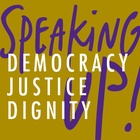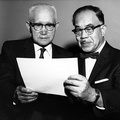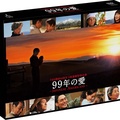Today's session is entitled "Democracy as expressed in Tanka, Haiku, and Senryu," and we will first look at his early works as "literature of the people," then at works that describe American life as "records of life, poetry of emotion," and finally at "American Populism: From Exclusion to Redress."
1. Popular Literature
Haiku, tanka, and senryu are literary forms that could be called the "national literature" of Japan, and were rooted in the lives of ordinary people. Naturally, they were created as a part of life even when they went to America. Combining historical materials such as immigration history, it is clear that haiku and tanka societies were established in San Francisco, Oakland, Seattle, and Portland around 1904.
The San Francisco Japanese-language newspaper "Shinsekai" has pages on microfilm dating back to 1906. If you look at the literary section, you can see that even in the small village of Vacaville, Japanese workers got together to form clubs and engage in activities, as in the work below.
Fireflies and the festival has passed in Uji village
(Yushuu, "Shinsekai," July 29, 1906, Vacaville News, Prize-winning haiku, Heaven)
The author of the second verse was Shimoyama Isso, who came to the United States in 1903 and was a free verse haiku poet active mainly in Los Angeles and San Francisco from the 1910s to the 1930s. He seems to have used many pen names and published children's songs and tanka poems.
Robins are singing in the rows of cultivated fields, spring is still young
(Isso, "Isso Kudo", January 1904)
Although Shimoyama's works have a sense of American life, many of his early works, both tanka and haiku, read as if they were written in Japan, like the one below.
The first day of the year shines through the small window of the plum tree, with the shadow of a bright and peaceful reign.
(Toshiko Kawai, New World, January 1st, 1907, Prize-winning tanka poem)
No matter how strong the anti-Japanese fervor, the Yamato cherry blossoms will bloom in full bloom.
(Fudeko, "New World," March 11, 1907)
Senryu is a type of poetry that was first written in the Yanagi barrel, and current affairs criticism was the first to be written. Most of the early works, including the one below, are now only left in the form of poems or verses published in newspapers.
The master of opening the country and now the theory of isolation
(Mumeibo, "New World," November 8, 1907)Komuraame: Immigrants cannot go out
(Shichimendo, "New World," December 6, 1908)
Recently, I came across a collection of poems by chance, called "Tsutanosha Poetry Collection" (Japanese Methodist Church, Seattle, United States of America), published in 1909. I have quoted it below. The author, Naosaku Ashizawa, seems to have lived at the Japanese Methodist Church in Seattle, but I found this book by chance in a used bookstore in Los Angeles. It expresses Christian faith, longing for home, and respect for the emperor.
Singing the name of the great god, I am able to live today with ease
The rising sun at the beginning of the year in Japan shines brightly in every country.
Even in the color of the falling snow, I think of my mother's shadow in her hometown.
Early haiku groups included the Rokuu-kai in Oakland, the Fudo-kai in Hood River, and tanka groups such as the Hakusen-kai and Nan'ei-kai, but records of most of the groups are not known at present other than from newspaper articles. As for the Sako-kai (or Shako-kai) in Seattle, the Sako-kai's book "Haiku Rokunen" (1912) is kept at the Senjin Memorial Museum in Morioka, and records their activities over a period of six years. Incidentally, this book was sent to Shimoyama Isso's family in Japan, where it has been preserved. The two haiku below are from "Haiku Rokunen."
A cold rock nose in the heat haze
(Teruhiro, February 1907)A mountain of warm water dripping onto a stone saw
(Usui, February 1912)
The haiku of the Lesser Cuckoo school were led by the Senakai Society (Furuya Musetsu, Shigetomi Tori, and Terada Nukesan) of the San Francisco Japan-America Newspaper in the 1910s, but initially the content was Japanese, as in the following work.
After the rain, the cicadas' voices grow louder
(Nukiyama, 1913 First Haiku Meeting, "Semigaeru Kai Kushu", 1923)Chilled udon noodles and the sounds of cicadas at the mountain pass teahouse
(Godo, 1913 First Haiku Meeting, "Semigaeru Kai Haiku Collection", 1923)
Tachibana Ginsha was founded in Los Angeles in 1922, with Tanaka Shuurin, Tsuneishi Shibao, Sakurai Gincho, Yasuda Hokko, and Fujioka Hosoe active there, while the Semigaeru-kai declined. Tachibana Ginsha was founded as a coterie magazine in 1926, and Tachibana Ginsha is still active today. Last year marked Tachibana's 90th year of activity. There are only a few copies of Tachibana from before the war at Waseda University, and the whereabouts of the rest are unknown. In Seattle, Renia Ginsha is still active. Kawajiri An'u, Miyake Taro, and Koike Banto were among the prewar leaders.
2. Records of life, poems of emotion
As mentioned above, at first, there were many Japanese-style works, but before long, they began to incorporate their own lives and feelings. "Records of life, poems of emotion" was a phrase used by a senryu instructor named Shimizu Kicho. His attitude towards composing haiku is well reflected in the pamphlet "Suzusebi" (Suzuhebi), which he dictated to the younger generation while in Jerome internment camp.
"If you look at your life honestly and honestly,
Modern Senryu is Born
This approach to composing can also be seen in the following tanka, which depicts a scene from daily life and captures the emotions felt at the time.
Turkey eaten alone has no taste. I celebrate with my wife and children with nostalgic zoni.
(Saitsugu, "New World," January 1, 1917)My fellow countrymen who work so hard that they forget their loneliness and hardships are sad.
(Masao Sakamoto, "New World," January 17, 1926)The joy I feel when I take off my big shoes after a day of work.
(Tahara Kurenai, "New World," March 27, 1927)I whip the horse but it doesn't move. My father is old and sweat is beading on his forehead.
(Iseda Hatsue, "Blue Clouds", 1930)Even when I have time to eat lunch, I'm busy. Will I just keep working and grow old?
(Tanaka Weijyo, "Kayo", 1927)
In tanka poetry, the Nan'ei Society was founded in Los Angeles in 1925, publishing "Seion" a year later and "Nankou" to commemorate its 10th anniversary. In Seattle, the Kayo Society was founded in 1925 and published "Kayo" (1927), but its last poetry meeting was on December 7, 1941. After the Idaho Minedoka Tanka Society, the Seattle Tanka Society is still active today.
In haiku, the free verse style of Shimoyama Isso, Naohara Binpei, and others was dominant from the 1910s to the 1930s, as can be seen in the works below. Fresno's Valley Ginsha, Stackton's Delta Ginsha, Los Angeles' Lemon Poetry Company, and Agosto Company were active.
Immigrants lose their wives and children to the rickety Ford
(Isso, "New World", May 17, 1925)A gravestone for a group of young immigrants who died, with red flowers in memorial
(Yasuji Ozawa, "New World," October 3, 1938)The branches reach out into the blue sky, and today, second generation people are getting married.
(Matsuda Aoki, "New World," December 21, 1936)
Senryu poetry societies were established later than tanka and haiku, but Yanagitaru and Yanagidan were intermittently published in newspapers. One notable poetry society is the North American Senryu Association in Seattle. This society has been active since 1929, except during wartime, and is the longest-lived poetry society. Records of its activities are kept in the North American Current Affairs magazine.
Praying for peace with America, sowing seeds
(Katsumi, North American Current Affairs, June 20, 1940)The world's greatest paradise, a thorny place to live
(I know, North American Current Affairs, March 26, 1940)I hate living here, but I can't give up on America
(Oka Taro, North American Current Affairs, July 23, 1938)
In Los Angeles, Tsubame Ginsha was founded in 1938 when a senryu column was established in the California Mainichi newspaper, and continued to be active, but is currently inactive. Rafu Senryu and Pioneer Senryu are related to that tradition in terms of personal connections.
*This is the manuscript of a presentation given in the Japanese session " Issei Poetry, Issei Voices " at the Japanese American National Museum's nationwide conference " Speaking Up! Democracy, Justice, Dignity, " held from July 4 to 7, 2013.
Listen to this session's presentation (audio only) >>
© 2013 Teruko Kumei











